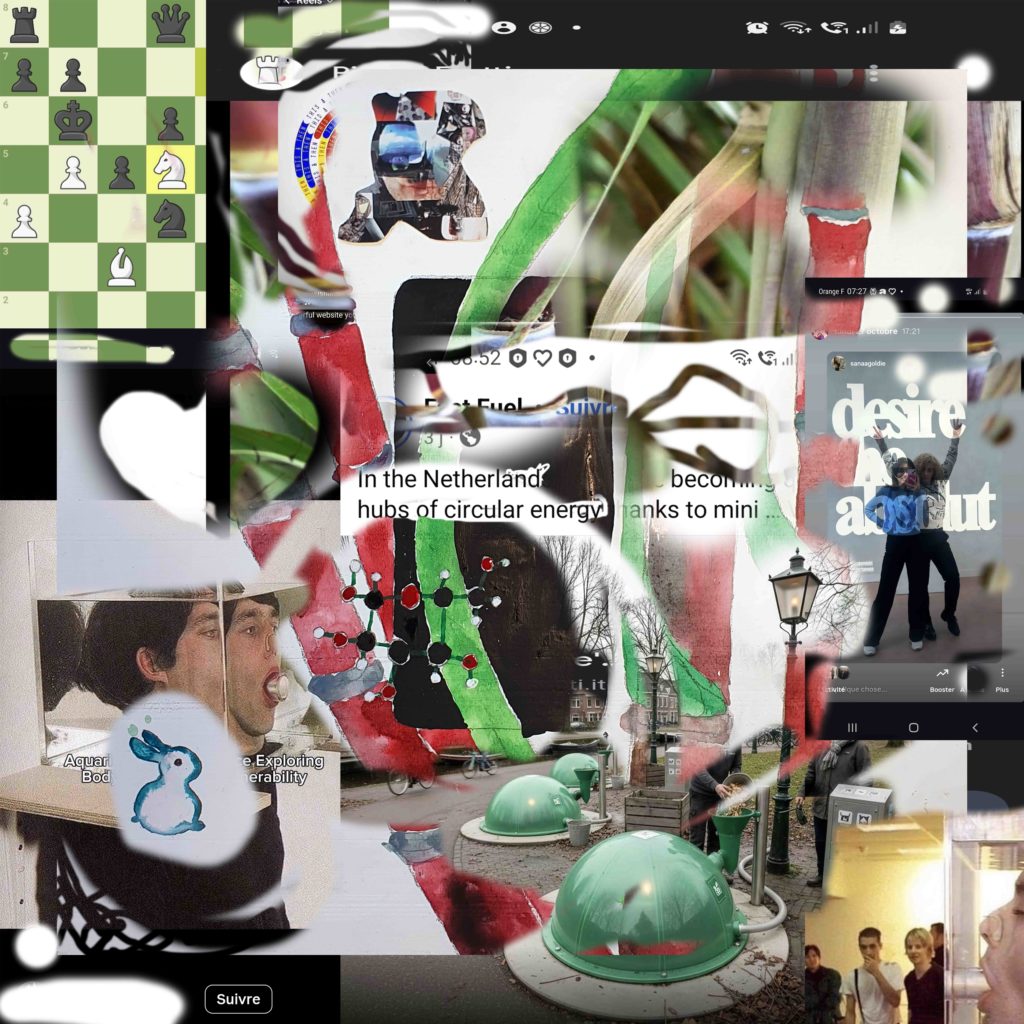
1 × 1 m
Print on Dibond, with the virtual sculpture Tracker visible through the AR FVT App
“Air, Sugar, Mirrors and Loops”
Dans cette œuvre de collage numérique, Fiona Valentine Thomann tisse une constellation d’images qui, à première vue, semblent étrangères les unes aux autres : le bassin d’Aquarium (1999) de Yael Davids, un plateau d’échecs numérique saisi sur l’application Chess, la peinture Canne à sucre issue de sa propre série Plantes psychoactives, la photographie source de cette même peinture inspirée du documentaire d’Arte Le sucre, pour la douceur et pour le pire, une capture d’écran d’elle-même et de Sanaa Goldie se reflétant dans un miroir à Desire the Absolute de @studiomonicabonvicini, une roue typographique générée par Space Type Generator répétant inlassablement this and then, et enfin une image issue d’un fun fact relatant l’installation de mini-dômes à biogaz aux Pays-Bas, alimentés par les déchets alimentaires et canins pour illuminer les parcs d’une douce combustion méthanée.
Ce tissage dense — à la fois documentaire et introspectif — compose un écosystème visuel respirant, où chaque fragment agit comme un micro-organe. Le point de départ, Aquarium de Yael Davids, ouvre le champ d’une réflexion sur notre vulnérabilité à l’air : cet espace invisible que nous partageons et qui nous relie. Le motif du plateau d’échecs, symbole de stratégie et de finitude (échec et mat), introduit une tension entre contrôle et abandon.
Le fil de la Canne à sucre relie ces éléments au capitalisme global : Thomann y superpose la peinture, sa photographie initiale et la mémoire du documentaire Le sucre, pour la douceur et pour le pire, qui expose les liens entre douceur, dépendance et colonialisme — où la saveur sucrée devient allégorie de l’exploitation. La présence de Fiona Valentine Thomann dans le reflet d’un miroir renvoie à la circularité du regard : l’artiste se regarde en train de regarder, et le spectateur, pris dans ce jeu optique, devient à son tour reflet.
Deux signes viennent ancrer cette constellation dans le langage propre de Thomann. Le premier est sa signature du lapin-canard, inspirée du test de réalité de Wittgenstein : figure ambiguë et oscillante qui incarne la dualité perceptive au cœur de son œuvre. Le second est l’inclusion du collage Tracker #2, accessible à travers l’application de réalité augmentée créée par l’artiste, AR FVT, qui révèle une sculpture virtuelle flottant dans l’espace, prolongeant le collage dans une dimension immatérielle et spéculative.
Ainsi,Biogas Dome for Light fonctionne comme un système respiratoire d’images et de flux, où la matière (sucre, air, méthane) et la pensée (jeu, mémoire, perception) se répondent en boucle. En hybridant le numérique et le sensible, Thomann nous confronte à une question essentielle : que devient notre respiration — physique, économique, symbolique — dans un monde saturé de réalités superposées ?
“Air, Sugar, Mirrors and Loops”
In this digital collage, Fiona Valentine Thomann weaves a constellation of images that at first appear unrelated: the basin from Aquarium (1999) by Yael Davids; a digital chessboard captured from the Chess app; the painting Canne à sucre (Sugar Cane) from her own series Plantes psychoactives (Psychoactive Plants); the photographic source that inspired this painting, itself influenced by the Arte documentary Le sucre, pour la douceur et pour le pire (Sugar: For Better or Worse); a screenshot of the artist with Sanaa Goldie reflected in a mirror at Desire the Absolute by @studiomonicabonvicini at Art Basel Paris; a typographic spiral generated by Space Type Generator endlessly repeating this and then; and finally, a screenshot of a “fun fact” describing the installation of mini biogas domes in the Netherlands—fed with food scraps and dog waste to softly illuminate public parks with methane light.
This dense, both documentary and introspective, weaving forms a breathing visual ecosystem, where each fragment acts as a micro-organism. Beginning with Yael Davids’s Aquarium, the work opens a reflection on our vulnerability to the air that surrounds us—this invisible space we share, which connects and sustains us. The motif of the chessboard, symbol of strategy and finality (checkmate), introduces a tension between control and surrender.
The thread of Canne à sucre links these elements to global capitalism: Thomann overlays the painting, its photographic origin, and the visual memory of the documentary Le sucre, pour la douceur et pour le pire, which exposes the links between sweetness, dependence, and colonialism—where the taste of sugar becomes an allegory of exploitation. The image of Fiona Valentine Thomann reflected in a mirror returns the gaze in a circular movement: the artist watches herself watching, while the viewer, caught in this optical loop, becomes a reflection in turn.
Two signatures anchor this constellation within Thomann’s visual language. The first is her rabbit–duck emblem, inspired by Wittgenstein’s reality test—an ambiguous, oscillating figure that embodies the perceptual duality at the core of her work. The second is the inclusion of the collage Tracker #2, visible through the artist’s augmented reality application AR FVT, which reveals a virtual sculpture floating in space, extending the collage into an immaterial and speculative dimension.
Thus, Biogas Dome for Light functions as a respiratory system of images and flows, where matter (sugar, air, methane) and thought (play, memory, perception) resonate in an endless loop. By hybridizing the digital and the sensorial, Thomann confronts us with an essential question: what becomes of our breath—physical, economic, symbolic—in a world saturated with overlapping realities?